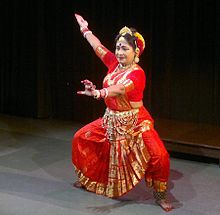Gaudiya Nritya (Bengali: Gaur̤īẏa Nṛtya or Gour̤īyo Nrityo) is a dance tradition.[2][3][4] This dance expressed religious stories[5] through songs written[6] and composed to the ragas & talas[7] of Gaudiya music by ancient poets, especially Vaishnavism.[8] Gaudiya Nritya performances have also expressed ideas of other traditions related to the Hindu deities Shiva[8] and Ganesha, as well as Shakta concepts.[9] It was reconstructed by Mahua Mukherjee in the 1980s and a research scholarship has since been awarded for it by the Indian Ministry of Culture.
| Instrument(s) | Anaddha, Ghana, Susir and Tata[1] |
|---|---|
| Origin | Gauda kingdom(ancient bengal), India West Bengal |

Etymology
editOn 21 September 1994, The name Gaudiya Nritya was adopted on the advice of Indologist Bratindra Nath Mukhopadhyay.[10] Reasons for this designation include: in ancient times – the reign of Shashanka and the Pala and Sena eras – the whole of Bengal was referred to as Gauda and the presence of the Gaudiya style in bengali music and literature. Also, in the fifteenth century, Sangeet Shastrakar Maheswara Mohapatra of Odisha mentions seven types of dance styles in Abhinaya Chandrika including Gaudiya dance.[11]
History
editThe theoretical foundations of Gaurika dance can be found in the ancient Sanskrit text Natyashastra;[12] Its existence in ancient times is attested by dance poses in sculptures of the Gaudiya style temple and archaeological sites associated with Hinduism, Buddhism and Jainism and it is mentioned by ancient poets of Bengal.[13] After colonial rule, it underwent revival, reconstruction and expansion in the 1980s.
It has been reconstructed by Mahua Mukherjee, a Bengali researcher and dancer. A research scholarship was awarded by the Ministry of Culture for this dance-based research.[14] Rabindra Bharati University and University of Oklahoma have recognized it as a classical dance form.[15][16][17][18]
References
edit- ^ Mukherjee 2000, p. 95.
- ^ Roma Chatterji (2005). Folklore and the Construction of National Tradition Archived February 12, 2018, at the Wayback Machine. Indian Folklife 19 (Folklore Abroad: On the Diffusion and Revision of Sociocultural Categories): 9. Accessed January 2014. "a classical dance tradition that has vanished from the urban areas".
- ^ "West Bengal Tourism: Dance". Department of Tourism, Government of West Bengal. 2011. Archived from the original on October 21, 2013. Retrieved January 11, 2014.
- ^ Bharatram, Kumudha (April 9, 2011). "Dance of the ancients". The Hindu. Retrieved November 15, 2013.
- ^ Mukherjee 2000, p. 179.
- ^ Mukherjee 2000, pp. 199–201.
- ^ Mukherjee 2000, p. 201.
- ^ a b Mukherjee 2000, p. 185.
- ^ Mukherjee 2000, p. 181.
- ^ Mukherjee 2000, p. 1.
- ^ Mukherjee 2000, pp. 1–2.
- ^ Mukherjee 2000, pp. 144–145.
- ^ Mukherjee 2000, pp. 5–40.
- ^ "Scholarship to Young Artistes, 2005". Ministry of Culture. Government of India. Archived from the original on October 21, 2013.
- ^ "Feet forgotten and found". www.telegraphindia.com. Retrieved January 25, 2022.
- ^ Utpal Kumar Banerjee (2006). Indian performing arts: a mosaic. New Delhi: Harman Publishing House. ISBN 9788186622759. p. 79: "re-creating Gaudiya Nritya as one of the acceptable classical styles will need a formal framework".
- ^ Leela Venkataraman (2006). Negotiating the Extremes: dance. India International Centre Quarterly, 33 (1): 93-102. (subscription required) "one may have reservations about the classical dance repertoire visualised by [Mukherjee]".
- ^ Roma Chatterji (2005). p. 9: "Mukherjee tries to reconstitute a Bengali aesthetic within the perspective of pan-Indian civilisation".
Bibliography
edit- Sengupta, Pallab; Banerjee, Manabendu; Mukherjee, Mahua, eds. (December 2005). Gaudiya Dance: A Coolection of Seminar Papers. 1 Park Street, Kolkata: The Asiatic Society.
{{cite book}}: CS1 maint: location (link) - Mukherjee, Mahua (January 2000). Gaur̤īẏa Nṛtya গৌড়ীয় নৃত্য [Gaudiya Dance] (in Bengali). 1 Park Street, Kolkata: The Asiatic Society.
{{cite book}}: CS1 maint: location (link)
External links
editMedia related to Gaudiya Nritya at Wikimedia Commons